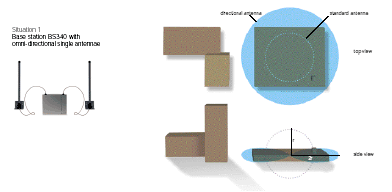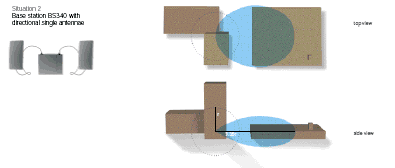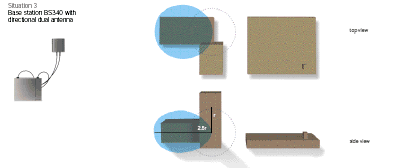Base stations enable radio communication between the radio exchange and cordless phones. A base station communicates with the radio exchange via two 2B+D interfaces, requiring a two twisted pair cable. The two 2B channels provide eight 32kbit/s speech path between a base station and the radio exchange, enabling a base station to handle eight simultaneous calls. Except for data communication these two twisted pairs can also be used to distribute power to the base stations.
Base stations can be powered either via a local power supply or via the modular cabinet. With the first method, an AC-adapter or another power source that is not routed via the cabinet powers base stations. The maximum cable length between base station and radio exchange is only data limited and may reach up to 3500 metres. With the second method, power is distributed via the cabinet and base station cabling. The cable length between base station and cabinet now depends on the number of twisted pairs used for power, the type of cable and environmental noise.
The number of base stations used in a system depends on the area to be covered and the traffic density. Typical in-house coverage is a 20-metre radius. In practice the cell size may vary between 10 metres indoors in worst case situations, up to 300 metres outdoors in free space.
The Ericsson BS3xx range of base stations offers a variety of coverage patterns to suit different situations. By choosing the right mix of base stations and the appropriate antennae quality coverage and sufficient traffic capacity exactly where needed can be ensured. |
| |
|
 |
The BS330 base station is the standard solution for most business premises. Typical indoor coverage is 30 metres, actual coverage depending on factors such as the spacing of walls and the building materials used. The BS330 supports up to 8 simultaneous speech calls per base station. Whilst the BS330 is primarily designed for indoor coverage, an outdoor housing is available for outdoor applications. Outdoor coverage is up to 300 metres. |
|
|
 |
The BS340 shares the basic characteristics of the BS330, but comes with two external antennas. These default antennae provide a spherical coverage pattern. A number of directional antennas are also available, which radiate more in certain directions than in others. The advantage is to direct coverage exactly where you need it, reducing overall cost in cases where the ideal coverage shape is not a sphere. |
| |
·Omni-directional single antenna. Coverage mainly in the horizontal plane. Effectively squashes the basic sphere of the BS340 into a shape closer to a discus. This doubles the range to a maximum of 600 metres in alle directions outdoors, with a reduced coverage in the vertical plane.
|
 |
| |
Directional single antenna
Coverage mainly in one direction. The coverage 'envelope' is flattened slightly, increasing the maximum range to 1000 metres. Most suitable for linear coverage,for example to cover walkways between buildings, tunnels, or to provide a radio link between a remote BS370 and a host base station.
|
 |
| |
|
|
Directional dual antenna
Coverage mainly in one direction. Compared to the directional single antenna, the maximum range is not as big but the height of the coverage 'envelope' is greater. |
 |
|
| BS370 wireless relay station |
 |
The BS370 wireless relay station is suitable for low to medium traffic capacity areas where cabling is a problem. The BS370 is connected to the cordless PBX via a radio link to a BS330 or BS340 'host' base station. It extends the coverage area of the host base station without the need to lay a new cable, saving man-hours and avoiding disruption. It only needs a local power adapter, so can for instance be mounted on a lamppost and use the same power supply. |
The BS370 has a maximum capacity of up to 5 simultaneous speech calls with handover in its coverage area. The host base station can support up to 8 simultaneous speech calls in its own coverage area, minus the number of calls made over the BS370 wireless relay station. The BS370 is usually positioned so that its coverage sphere overlaps with that of the host base station. However, it also has an input for a 3rd antenna, usually the directional single antenna. This means it can be placed up to 1000 metres away. |
| |
|
|